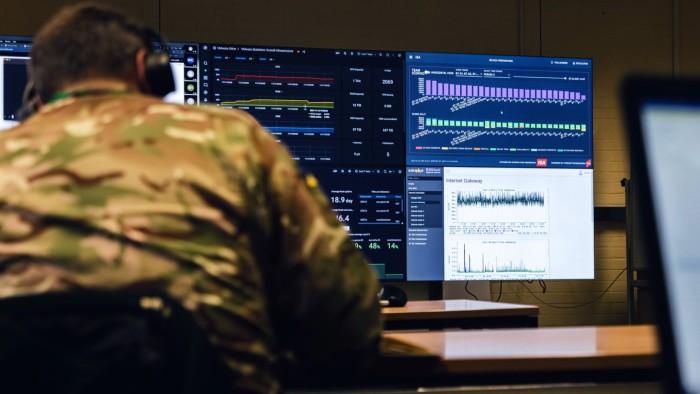Unlock the Editor’s Digest for free
Roula Khalaf, Editor of the FT, selects her favourite stories in this weekly newsletter.
The UK military will unify cyber and electronic operations under a single command as part of a sweeping reorganisation of high-tech warfare, defence secretary John Healey has announced.
The move will be a central plank of the government’s strategic defence review, expected to be unveiled on Monday, that will lay out military spending plans and priorities for the coming years.
The Ministry of Defence also plans to spend more than £1bn developing an artificial intelligence-driven system to analyse and filter the gargantuan amounts of data generated across the military.
This is part of a broader effort to digest the military lessons learned during the Ukraine conflict, which has seen Ukraine use technology to hold off a numerically superior enemy.
On a visit to the UK military’s cyber command at MOD Corsham in Wiltshire on Wednesday, Healey defended Britain’s spending commitments in the face of pressure from the US and other Nato allies to increase funding for the armed forces.
Faced with an increasingly belligerent Russia, Prime Minister Keir Starmer has pledged an extra £5bn this year to get defence spending to the threshold of 2.5 per cent of GDP by 2027 and 3 per cent by the next election. However, this may not be enough for Nato allies.
On Monday, Nato secretary-general Mark Rutte said he assumed Nato would agree a defence spending target of 5 per cent of GDP, 3.5 per cent on pure defence and 1.5 per cent on broader security related items, in line with demands from US President Donald Trump.
Any disagreements are likely to come to a head later this month at Nato’s annual summit in The Hague.
“We have always played our part in Nato,” Healey said, addressing Rutte’s comments. “And we go into the summit ready to plan to meet our capability commitments. We’ll make our commitments to Nato. But above all, Britain will become the leading European nation in Nato.”
Speaking at MOD Corsham, Healey said “we’re under daily attack” in the cyber domain. “And this is the nerve centre of the UK’s military that helps us defend against these attacks . . . the keyboard has become a weapon of war.
“In future conflicts — and we learned this lesson from Ukraine — those that prevail will be those who are not just better equipped and better trained, but better connected.”
The new National Cyber and Electromagnetic Command will unite the UK’s cyber personnel, who straddle the signals intelligence agency GCHQ, the Ministry of Defence and other government units.
The National Cyber Force, which oversees “offensive” cyber operations, will stay independent under the plan. The new cyber command — similar but not identical to the Cyber Force created a decade and a half ago by the Pentagon — will unify a series of smaller units into a national command alongside NCF.
Experts were sceptical of the reorganisation. “I’m of two minds,” said one serving reserve officer who asked that his name not be used. “Obviously, electronic warfare and cyber are critical. But I’m not sure the way to cut through bureaucracy is to create more organisations and layers.”
The new “digital targeting web” system, meanwhile, aims to knit together data gathered across a battlefield and translate it into better intelligence about what an adversary is doing, but on a larger scale than current software in use such as Maven, designed by US defence company Palantir. Defence officials insisted that no single system or company would provide the whole picture, which one described as a “system of systems”.
“It is a serious level of investment and shows it’s a real priority,” said Will Blyth, chief executive and co-founder of Arondite, a UK defence software company.




